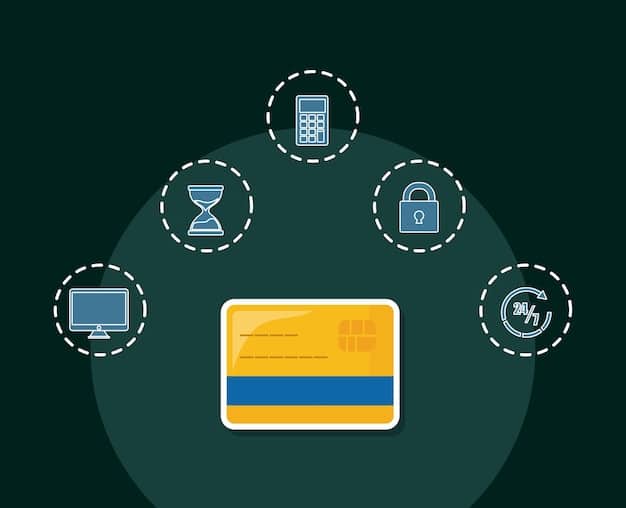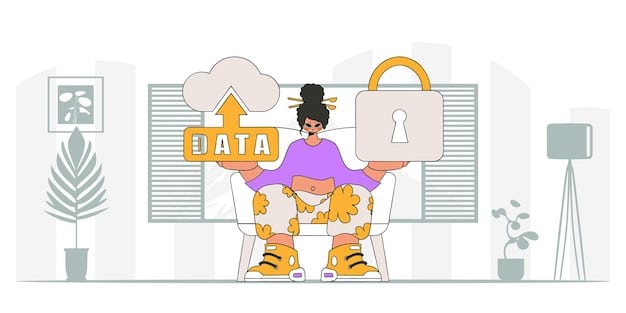Tokenization vs. Encryption: Payment Security for US E-commerce

Tokenization vs. encryption are vital security methods for US e-commerce, protecting sensitive payment data. Tokenization replaces data with non-sensitive equivalents, while encryption scrambles data, both helping to secure transactions and maintain customer trust.
In the landscape of US e-commerce, securing payment transactions is paramount. Two key methods, tokenization vs. encryption, offer distinct ways to protect sensitive customer data. Understanding their differences and applications is crucial for any e-commerce business aiming to maintain security and customer trust.
This article will explore each method in detail, providing insights to help you choose the right payment security strategy for your US e-commerce business.
Understanding the Basics: Tokenization vs. Encryption in E-commerce
When it comes to protecting sensitive payment information in e-commerce, tokenization vs. encryption are frequently discussed. Both methods aim to safeguard cardholder data, but they operate in fundamentally different ways. This section will explore the basic principles behind each approach and explain how they contribute to a more secure online transaction environment for US e-commerce businesses.
What is Tokenization?
Tokenization replaces sensitive data, such as credit card numbers, with a non-sensitive equivalent, known as a token. This token can then be used for transactions without exposing the actual card details.
What is Encryption?
Encryption involves scrambling data using an algorithm, rendering it unreadable to unauthorized parties. The data can only be decrypted using a specific key.

- Data Masking: Tokenization effectively masks the original data, reducing the risk of exposure in the event of a breach.
- Limited Scope: Even if a token is compromised, it cannot be used to derive the original card information.
- Compliance Benefits: Using tokenization can simplify PCI DSS compliance by reducing the amount of sensitive data that needs to be protected.
In summary, while encryption protects data by making it unreadable without a key, tokenization reduces the value of the data itself, substantially decreasing the consequences if a breach occurs. Both are critical in a comprehensive security strategy, making the choice between tokenization vs. encryption complex and dependent on specific business needs.
How Tokenization Works in E-commerce Payment Processing
Tokenization is a critical process in securing e-commerce payments. It mitigates risk by ensuring that actual credit card data is never stored on the e-commerce site or transmitted across its networks. Let’s explore how tokenization works in the context of e-commerce payment processing to understand why it’s a vital tool for US businesses.
The Tokenization Process
When a customer enters their credit card information on an e-commerce site, the data is sent to a secure tokenization service. This service then replaces the card number with a unique token, which is returned to the e-commerce site. The actual card data is stored securely in a remote vault, inaccessible to the e-commerce system.
Benefits of Using Tokenization
Tokenization offers numerous benefits for e-commerce businesses, including reduced PCI scope, enhanced security, and improved customer trust.
- Reduced PCI Scope: By not storing or processing actual card data, e-commerce businesses can significantly reduce their PCI DSS compliance burden.
- Enhanced Security: Tokens are useless to hackers, providing an additional layer of security against data breaches.
- Flexibility: Tokens can be used across multiple channels and devices, making them ideal for omnichannel retail environments.
Understanding the mechanics of how tokenization functions within e-commerce payment processing underscores its importance in protecting both businesses and their customers. The decision of tokenization vs. encryption should take these advantages into account when formulating a robust security strategy.
Understanding Encryption in E-commerce Payment Processing
Encryption is another foundational method for protecting sensitive data during e-commerce transactions. Unlike tokenization, which replaces data, encryption transforms it into an unreadable format. Let’s delve into how encryption is applied in e-commerce payment processing to understand its role in data security.
How Encryption Works
Encryption uses complex algorithms to scramble data, ensuring that it cannot be understood without the decryption key. In e-commerce, this often involves encrypting cardholder data as it is transmitted from the customer’s browser to the payment gateway.
Types of Encryption Used in E-commerce
Several encryption methods are commonly employed in e-commerce, including Transport Layer Security (TLS) and Secure Sockets Layer (SSL), which protect data in transit, and encryption algorithms like AES for data at rest.

- Data in Transit: Encryption protocols like TLS and SSL ensure that data cannot be intercepted and read during transmission.
- Data at Rest: Encryption algorithms like AES protect cardholder data when it is stored on servers or databases.
- Key Management: Proper key management is critical to the overall security of encryption, ensuring that only authorized parties have access to decryption keys.
Encryption is a powerful tool for safeguarding e-commerce transactions by protecting data both during transmission and when stored. However, when comparing tokenization vs. encryption, it’s crucial to consider the specific security needs and compliance requirements of your business.
Key Differences & Similarities Between Tokenization and Encryption
When evaluating tokenization vs. encryption for securing payment data in your US e-commerce business, it’s essential to understand their key differences and similarities. Both approaches aim to protect sensitive information, but they do so using distinct methods, each with its own strengths and weaknesses.
Data Transformation vs. Data Masking
Encryption transforms sensitive data into an unreadable format, whereas tokenization replaces it with a non-sensitive equivalent. This fundamental difference impacts how the data is handled and protected.
PCI Compliance Implications
Both methods can help reduce PCI DSS compliance scope, but tokenization generally offers more significant reductions because it minimizes the amount of sensitive data that needs protection.
Use Cases and Flexibility
Encryption is suitable for protecting data in transit and at rest, while tokenization is ideal for situations where data needs to be used in multiple contexts without exposing the original information.
- Security Levels: While encryption secures data by making it unreadable, tokenization reduces the value of the data itself, thereby minimizing the impact of a potential breach.
- Cost Considerations: The costs associated with implementing and maintaining each method can vary, depending on the specific solutions and services required.
- Integration Complexity: Integrating tokenization or encryption into an existing e-commerce platform may require significant technical expertise and resources.
Understanding these key differences and similarities will help US e-commerce businesses make informed decisions about which method, or combination of methods, is most appropriate for their specific security needs and operational requirements when considering tokenization vs. encryption.
Making the Right Choice: Tokenization vs. Encryption for Your US E-commerce Business
Choosing between tokenization vs. encryption involves assessing various factors relevant to your US e-commerce business. This decision should align with your security goals, compliance requirements, and operational needs. Consider these factors to make an informed choice that best protects your business and customers.
Assessing Your Business Needs
Evaluate the types of transactions you process, the amount of sensitive data you handle, and the compliance standards you must meet. This assessment will help you determine the level of security you need.
Considering Compliance Requirements
Ensure that the security method you choose helps you meet PCI DSS and other relevant compliance requirements. Tokenization can often simplify compliance by reducing the scope of sensitive data.
Evaluating Costs and Resources
Assess the costs associated with implementing and maintaining each method, as well as the resources required for integration and ongoing management.
- Hybrid Approach: Many businesses opt for a hybrid approach, using both tokenization and encryption to provide comprehensive security.
- Scalability: Consider how well each method can scale as your business grows and your transaction volumes increase.
- Vendor Selection: Choose a reputable vendor with expertise in payment security and a proven track record of protecting sensitive data.
Selecting the right security method involves a thorough evaluation of your business needs, compliance requirements, costs, and resources. A well-informed decision will significantly enhance your e-commerce security posture, providing peace of mind for both you and your customers. Keeping the nuances of tokenization vs. encryption in mind will also help you maintain a strong reputation in the US market.
| Key Aspect | Brief Description |
|---|---|
| 🔑 Tokenization | Replaces sensitive data with non-sensitive tokens, reducing PCI scope. |
| 🔒 Encryption | Transforms data into unreadable format, securing data in transit and at rest. |
| 🛡️ Security | Both enhance security, but tokenization minimizes impact of breaches due to data masking. |
| 🤝 Hybrid Approach | Combining both offers comprehensive security for US e-commerce businesses. |
Frequently Asked Questions
Tokenization replaces sensitive data with non-sensitive tokens, reducing the risk of exposure. Encryption, on the other hand, transforms data into an unreadable format, protecting it during transit and storage, making tokenization vs. encryption distinct strategies.
Tokenization reduces the scope of PCI DSS compliance by minimizing the amount of sensitive cardholder data that needs to be protected. Since the actual data is stored securely in a remote vault, it simplifies the compliance process.
While encryption is crucial for securing data in transit and at rest, it may not be sufficient on its own. Combining encryption with other security measures like tokenization provides a more robust defense against potential threats. Properly weighing tokenization vs. encryption will improve your defense.
No, tokens are designed to be irreversible. The tokenization process ensures that there is no mathematical or algorithmic relationship between the token and the original card data, making it impossible to derive the card number from the token.
Using both tokenization vs. encryption provides a layered security approach. Encryption protects data during transmission and storage, while tokenization minimizes the impact of a breach by replacing sensitive data with useless tokens, enhancing overall security.
Conclusion
Choosing between tokenization vs. encryption for your US e-commerce business is a decision that should be based on your specific needs, compliance requirements, and risk tolerance. Both methods offer valuable security benefits and can be used in conjunction to provide comprehensive protection.
By understanding the nuances of each approach and carefully evaluating your business circumstances, you can make an informed decision that safeguards your customers’ data and ensures the long-term success of your e-commerce operations.





